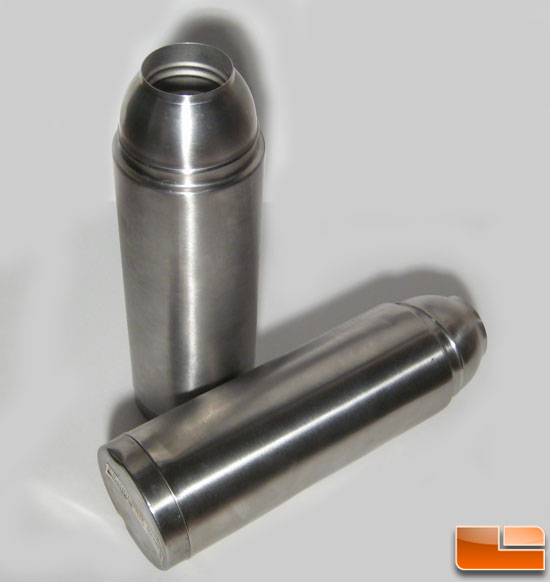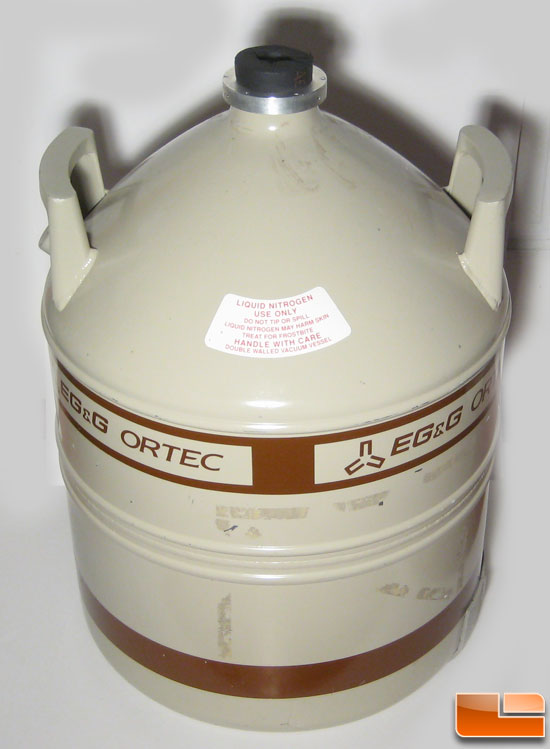Koolance CPU-LN2 Liquid Nitrogen Evaporator
Preparation for Dry Ice and LN2 Benching
Dry ice and LN2 benching are actually very safe and fun activities to engage in so long as a little preparation is taken care of. First and foremost both substances will cause serious frostbite to your skin if you maintain prolonged contact with them. Dry ice has a tendency when held in the hand to freeze to the sweat on the hand and liquid nitrogen will quickly freeze anything it remains in contact with. Luckily for you liquid nitrogen is so cold that it evaporates immediately when it hits your skin and will roll off harmless however if it lands in your shoe via the laces you’ll find yourself kicking your shoes off very quickly. Dry ice and liquid nitrogen also expand to several hundreds times their solid/liquid volumes, for example liquid nitrogen expands to 694 times it’s liquid volume. Because of this you should never seal either substances in a container not designed for cryogenic storage with appropriate pressure release valves.
If you have any more concerns about dry ice and liquid nitrogen feel free to email me. Reading all that may sound scary but in actuality both are quite safe and easy to work with. Now, preparing to use both require a few special containers. For dry ice I like to use thick styrofoam coolers to store the dry ice while I’m using it. Dry ice also is easiest used in powdered or pellet form. Unfortunately it often comes in large 5 pound to 10 pound bricks. In this case I suggest getting an old pillow case, a pair of safety glasses, and a hammer. Put the dry ice with it’s original plastic bag into the pillow case and tie off the pillow case. Hit the dry ice a few times with the hammer to break it up into larger chunks and then beat the pillow case against a concrete slab like a drive way or street. It may sound silly but with a few hits the dry ice will fall apart into a powder form with a few large chunks. Dump this into your cooler and you are set to go. I use a large ceramic coffee cup to scoop the dry ice powder out of the cooler. If you use anything metal to scoop be careful as the dry ice will chill it down considerably.
Liquid nitrogen is a bit more difficult to work with given how much colder it is. Styrofoam isn’t a sufficient insulator, for liquid nitrogen you need purpose build dewars. A dewar is a two-walled steel or aluminum container with a vacuum pulled in between the two walls. This vacuum insulation reduces LN2 loss from dozens of liters per day to a fraction of a liter per day with a good dewar. Dewars may be rented from some suppliers but if you plan on making this a hobby I suggest purchasing a dewar. Search around, a decent 25 liter to 35 liter dewar can be found for $300 USD or less if you are patient. Working with liquid nitrogen is a lot like working with water. I use 1 liter coffee flasks and tip the larger 35L dewar till a small stream of liquid nitrogen pours out and I fill the hand flasks with this.
I’ve grown rather comfortable benching with LN2 and dry ice and bench without gloves however I would suggest wearing some thin gloves to keep yourself from accidentally grabbing something cold and giving yourself frost-bite. Besides all this storage and usage preparation you will also need to prepare your motherboard. A few months back I wrote this Liquid Nitrogen and Dry Ice Insulation Guide, I’d suggest following it and using either plasticine or artist eraser to insulate the board.



Comments are closed.